Contacting Us
Introduction
Symbols Glossary
Data Privacy
Visual Search
Child Safety
- Child Safety Precautions
- Booster Seats
- Child Safety Locks
Child Restraint Anchor Points
Child Restraints
Installing Child Restraints
Seatbelts
- Seatbelt Precautions
- Fastening and Unfastening the Seatbelts
- Adjusting the Seatbelts During Pregnancy
- Adjusting the Seatbelt Height
- Checking the Seatbelts
- Seatbelt Extensions
Sensitive Locking Mode
Automatic Locking Mode
Seatbelt Reminder
Personal Safety System™
Airbags
- How Do the Front Airbags Work
- How Do the Side Airbags Work
- How Do the Knee Airbags Work
- How Does the Safety Canopy™ Work
- Airbag Precautions
- Properly Adjusting the Driver and Front Passenger Seats
- Children and Airbags
- Crash Sensors and Airbag Indicator
- Disposing of Airbags
Front Passenger Sensing System
Pedestrian Alert System
911 Assist
Keys and Remote Controls
Phone as a Key
MyKey™
- What Is MyKey
- Creating a MyKey
- Programming a MyKey
- Clearing All MyKeys
- Checking MyKey System Status
- Using MyKey With Remote Start Systems
MyKey Settings
MyKey – Troubleshooting
Doors and Locks
- Doors and Locks Audible Warnings
- Doors and Locks Videos
Operating the Doors From Outside Your Vehicle
Operating the Doors From Inside Your Vehicle
Autounlock
Autolock
Mislock (If Equipped)
Doors and Locks – Troubleshooting
Keyless Entry
- Keyless Entry Limitations
- Keyless Entry Settings
- Using Keyless Entry
Keyless Entry – Troubleshooting
Keyless Entry Keypad
Walk Away Lock
Easy Entry and Exit
Liftgate - Vehicles With: Hands-Free Liftgate/Power Liftgate
- Liftgate Precautions
- Setting the Liftgate Opening Height
- Stopping the Liftgate Movement
- Liftgate Obstacle Detection
Opening the Liftgate
Closing the Liftgate
Liftgate – Troubleshooting
Liftgate - Vehicles With: Manual Liftgate
Opening the Liftgate
Closing the Liftgate
Security
Passive Anti-Theft System
Anti-Theft Alarm System
Anti-Theft Alarm System Settings
Security – Troubleshooting
Wipers and Washers
- Switching the Rear Window Wiper On and Off
- Checking the Wiper Blades
- Replacing the Front Wiper Blades
- Replacing the Rear Wiper Blades
Reverse Wipe
Washers
Wipers and Washers – Troubleshooting
Exterior Lighting
- Exterior Lighting Control
- Using the Turn Signal Lamps
- Switching the Daytime Running Lamps On and Off - Vehicles With: Configurable Daytime Running Lamps
- Switching the Daytime Running Lamps On and Off - Vehicles With: Daytime Running Lamps (DRL)
- Switching Welcome Lighting On and Off
- Exterior Lamp Indicators
- Exterior Lamps On Audible Warning
Headlamps
Headlamps – Troubleshooting
Autolamps
Exterior Lamps
Automatic High Beam Control
Automatic High Beam Control – Troubleshooting
Interior Lighting
- Switching All of the Interior Lamps On and Off
- Switching the Front Interior Lamps On and Off
- Switching the Rear Interior Lamps On and Off
- Adjusting the Instrument Panel Lighting Brightness
Interior Lamp Function
Ambient Lighting (If Equipped)
Interior Lighting – Troubleshooting
Windows
- Opening and Closing the Windows
- Locking the Rear Window Controls
Global Opening and Closing
Window Bounce-Back
Interior Mirror
- Interior Mirror Precautions
Auto-Dimming Interior Mirror
Exterior Mirrors
Instrument Cluster
- Instrument Cluster Overview - Excluding: GT
- Instrument Cluster Overview - GT
- Power Gauge - GT
- Speedometer
- Vehicle Range Display
- High Voltage Battery Gauge
- What Are the Instrument Cluster Warning Lamps
- Instrument Cluster Warning Lamps
- What Are the Instrument Cluster Indicators
- Instrument Cluster Indicators
Instrument Cluster Display
Trip Computer
Remote Start
Climate Control
- Identifying the Climate Control Unit
- Switching Climate Control On and Off
- Switching Recirculated Air On and Off
- Switching Air Conditioning On and Off
- Switching Defrost On and Off
- Switching Maximum Defrost On and Off
- Switching Maximum Cooling On and Off
- Switching the Heated Wiper Park On and Off
- Switching the Heated Rear Window On and Off
- Setting the Blower Motor Speed
- Switching the Heated Mirrors On and Off
- Setting the Temperature
- Directing the Flow of Air
- Climate Control Hints
Interior Air Quality
Front Seats
- Front Seat Precautions
- Sitting in the Correct Position
- Head Restraint Components
- Adjusting the Head Restraint - Vehicles With: Front Fixed Head Restraints
- Adjusting the Head Restraint - Vehicles With: Front Adjustable Head Restraints
- Removing the Head Restraint
- Installing the Head Restraint
- Moving the Seat Backward and Forward
- Adjusting the Seat Backrest
- Adjusting the Seat Height
- Adjusting the Lumbar Support
Manual Seats
Power Seats
Heated Seats (If Equipped)
Rear Seats
Rear Occupant Alert System (If Equipped)
Memory Function (If Equipped)
Garage Door Opener
Wireless Accessory Charger
- What Is the Wireless Accessory Charger
- Wireless Accessory Charger Precautions
- Locating the Wireless Accessory Charger
- Charging a Wireless Device
Wireless Accessory Charger – Troubleshooting
Storage
Cup Holders
Glove Compartment
Glasses Holder
Starting and Powering Off
High Voltage Battery
Charging Your Vehicle
- What is AC Charging
- What is DC Charging
- Charging Your Vehicle Precautions
- Charging Equipment
- Locating the Charge Port
- Charge Port Indicators
- Setting the Charging Schedule and Preferences
- Using FordPass and Charging
- Charging Your Vehicle Hints
- Charging Your Vehicle Videos
AC Charging
DC Charging
Charging Your Vehicle – Troubleshooting
Automatic Transmission
- Automatic Transmission Precautions
- Shifting Your Vehicle Into Gear
Automatic Transmission Positions
Temporary Neutral Mode
Automatic Return to Park (P)
All-Wheel Drive (If Equipped)
- How Does All-Wheel Drive Work
- All-Wheel Drive Precautions
- All-Wheel Drive Limitations
All-Wheel Drive – Troubleshooting
Brakes
- Brake Precautions
- Brake Over Accelerator
- Locating the Brake Fluid Reservoir
- Checking the Brake Fluid
- Brake Fluid Specification
Anti-Lock Braking System
Brakes – Troubleshooting
Electric Parking Brake
- What Is the Electric Parking Brake
- Applying the Electric Parking Brake
- Applying the Electric Parking Brake in an Emergency
- Manually Releasing the Electric Parking Brake
- Automatically Releasing the Electric Parking Brake
- Electric Parking Brake Audible Warning
- Releasing the Electric Parking Brake if the Vehicle Battery Has Run Out of Charge
Electric Parking Brake – Troubleshooting
Reverse Brake Assist
Hill Start Assist
Auto Hold
Traction Control
Stability Control
Steering
Electric Power Steering
Steering – Troubleshooting
Parking Aids
- Parking Aid Precautions
- Switching Parking Aid On and Off
- Parking Aid Indicators
- Parking Aids Videos
Rear Parking Aid
Front Parking Aid
Side Parking Aid (If Equipped)
Parking Aids – Troubleshooting
Rear View Camera
360 Degree Camera (If Equipped)
Active Park Assist (If Equipped)
Adaptive Cruise Control
- How Does Adaptive Cruise Control With Stop and Go Work
- Adaptive Cruise Control Precautions
- Adaptive Cruise Control Limitations
- Switching Adaptive Cruise Control On and Off
- Adaptive Cruise Control Automatic Cancellation
- Setting the Adaptive Cruise Control Speed
- Setting the Adaptive Cruise Control Gap
- Canceling the Set Speed
- Resuming the Set Speed
- Overriding the Set Speed
- Adaptive Cruise Control Indicators
- Switching From Adaptive Cruise Control to Cruise Control
Lane Centering
Predictive Speed Assist
Predictive Speed Assist – Troubleshooting
Adaptive Cruise Control – Troubleshooting
BlueCruise (If Equipped)
- What Is BlueCruise
- How Does BlueCruise Work
- BlueCruise Precautions
- BlueCruise Requirements
- BlueCruise Limitations
- BlueCruise Settings
- Switching BlueCruise On and Off
- BlueCruise Alerts
- BlueCruise Automatic Cancellation
- BlueCruise Indicators
Lane Change Assist
Lane Change Assist – Troubleshooting
In-Lane Repositioning
BlueCruise – Troubleshooting
Drive Mode Control
One Pedal Drive
Lane Keeping System
- What Is the Lane Keeping System
- How Does the Lane Keeping System Work
- Lane Keeping System Precautions
- Lane Keeping System Limitations
- Switching the Lane Keeping System On and Off
- Switching the Lane Keeping System Mode
- Lane Keeping System Settings
- Lane Keeping System Indicators
Alert Mode
Aid Mode
Alert and Aid Mode
Blind Spot Assist
Lane Keeping System – Troubleshooting
Blind Spot Information System
- What Is Blind Spot Information System
- How Does Blind Spot Information System Work
- Blind Spot Information System Precautions
- Blind Spot Information System Limitations
- Blind Spot Information System Requirements
- Switching Blind Spot Information System On and Off
- Locating the Blind Spot Information System Sensors
- Blind Spot Information System Indicators
Blind Spot Information System – Troubleshooting
Cross Traffic Alert
Pre-Collision Assist
- What Is Pre-Collision Assist
- How Does Pre-Collision Assist Work
- Pre-Collision Assist Precautions
- Pre-Collision Assist Limitations
- Switching Pre-Collision Assist On and Off
- Locating the Pre-Collision Assist Sensors
Distance Indication
Automatic Emergency Braking
Evasive Steering Assist
Pre-Collision Assist – Troubleshooting
Speed Sign Recognition
- What Is Speed Sign Recognition
- How Does Speed Sign Recognition Work
- Speed Sign Recognition Precautions
- Speed Sign Recognition Limitations
- Speed Sign Recognition Indicators
- Setting the Speed Sign Recognition Speed Warning
- Setting the Speed Sign Recognition Speed Tolerance
Speed Sign Recognition – Troubleshooting
Driver Alert
Load Carrying
Luggage Compartment
Towing a Trailer
Driving Hints
- Cold Weather Precautions
- Driving on Snow and Ice
- Breaking-In
- Performance Vehicle Precautions
- Driving Through Shallow Water
- Floor Mats
Driving in Special Conditions
Electric Vehicle
Crash and Breakdown Information
- Roadside Assistance
- Switching the Hazard Flashers On and Off
- Post-Collision Braking
- Transporting the Vehicle
Jump Starting the Vehicle
Post-Crash Alert System
Automatic Crash Shutoff
Towing Your Vehicle
- Towing Your Vehicle Precautions
- Recreationally Towing Your Vehicle
- Emergency Towing
Towing Your Vehicle – Troubleshooting
Fuses
- Fuse Precautions
- Identifying Fuse Types
Under Hood Fuse Box
Battery Fuse Box
Body Control Module Fuse Box
Fuses – Troubleshooting
Maintenance
- Maintenance Precautions
- Opening and Closing the Hood
- Under Hood Overview
- Checking the Coolant
- Automatic Transmission Fluid Check
- Adjusting the Headlamps
12V Battery
12V Battery – Troubleshooting
Exterior Bulbs
Interior Bulbs
Vehicle Care
- General Information
- Cleaning Products
- Waxing
- Repairing Minor Paint Damage
Cleaning the Exterior
Cleaning the Interior
Body Styling Kits
Storing Your Vehicle
Wheel and Tire Information
Tire Care
Tire Sealant and Inflator Kit
Tire Pressure Monitoring System
- What Is the Tire Pressure Monitoring System
- Tire Pressure Monitoring System Overview
- Tire Pressure Monitoring System Precautions
- Tire Pressure Monitoring System Limitations
- Viewing the Tire Pressures
Tire Pressure Monitoring System – Troubleshooting
Changing a Road Wheel
Capacities and Specifications
Vehicle Identification
- Installing the Vehicle Identification Card
Vehicle Identification Number
Connected Vehicle
- What Is a Connected Vehicle
- Connected Vehicle Requirements
- Connected Vehicle Limitations
- Connecting the Vehicle to a Wi-Fi Network
- Connected Vehicle Settings
Connecting the Vehicle to a Mobile Network
Connected Vehicle – Troubleshooting
Vehicle Wi-Fi Hotspot
Audio System
- Audio System Precautions
- Switching the Audio Unit On and Off
- Selecting the Audio Source
- Playing or Pausing the Audio Source
- Adjusting the Volume
- Switching Shuffle Mode On and Off
- Switching Repeat Mode On and Off
- Setting a Memory Preset
- Muting the Audio
- Adjusting the Sound Settings
- Setting the Clock and Date
AM/FM Radio
Digital Radio
Satellite Radio
Audio System – Troubleshooting
Center Display
Voice Interaction
Alexa Built-In
Phone
Apps
Personal Profiles
Navigation
- Connected Navigation
- Accessing Navigation
- Navigation Map Updates
Adjusting the Map
Live Traffic
Setting a Destination
Waypoints
Vehicle Software Updates
Vehicle System Reset
Accessories
Ford Protect
Scheduled Maintenance
Customer Information
- Rollover Warning
- The Better Business Bureau Auto Line Program
- The Mediation and Arbitration Program
- Ordering a Canadian French Owner's Manual
- Reporting Safety Defects in the United States
- Reporting Safety Defects in Canada
- Declaration of Conformity
- Type Approvals
- Perchlorate
- Replacement Parts Recommendation
- Mobile Communications Equipment
- Federal Highway Administration Regulation
- End User License Agreement
- Export Unique Options
Radio Frequency Certification Labels
Appendices
This view of the Owner's Manual contains the very latest information, which may vary slightly from the printed Owner's Manual originally provided with your vehicle. It may also describe content that is not on or operates differently on your vehicle. Please consider the Owner's Manual originally provided with your vehicle as the primary source of information for your vehicle.

The information contained in this publication was correct at the time of release.In the interest of continuous development, we reserve the right to change specifications, design or equipment at any time without notice or obligation.No part of this publication may be reproduced, transmitted, stored in a retrieval system or translated into any language in any form by any means without our written permission.Errors and omissions excepted.
Copyright © 2024 Ford Motor Company
Using the Tire Sealant and Inflator Kit
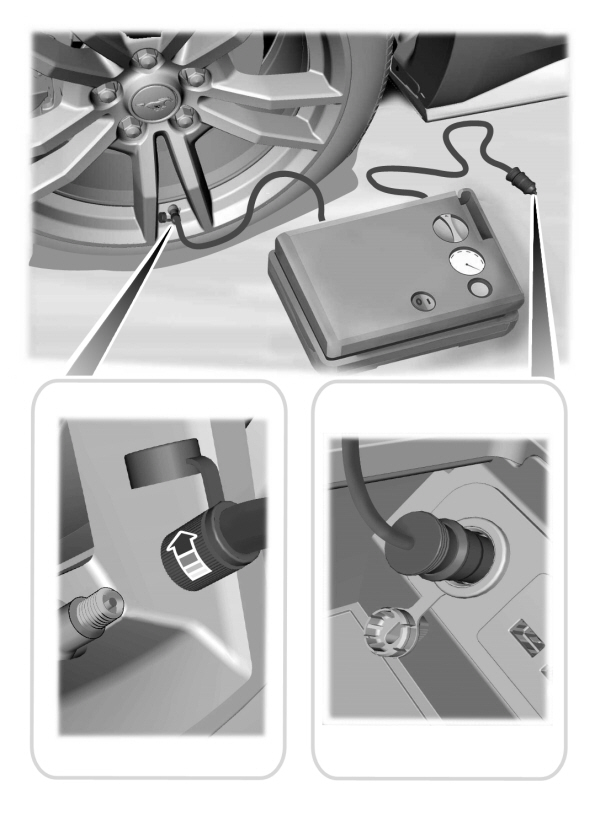
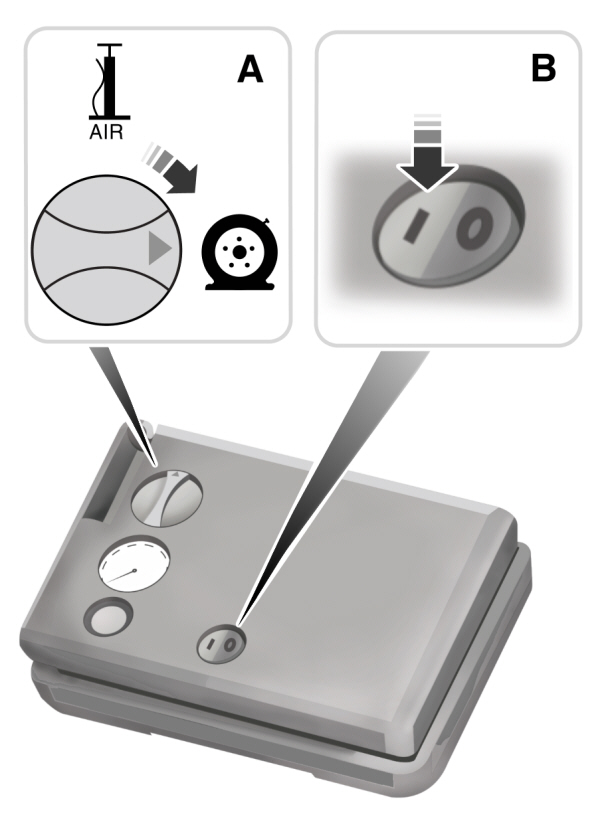
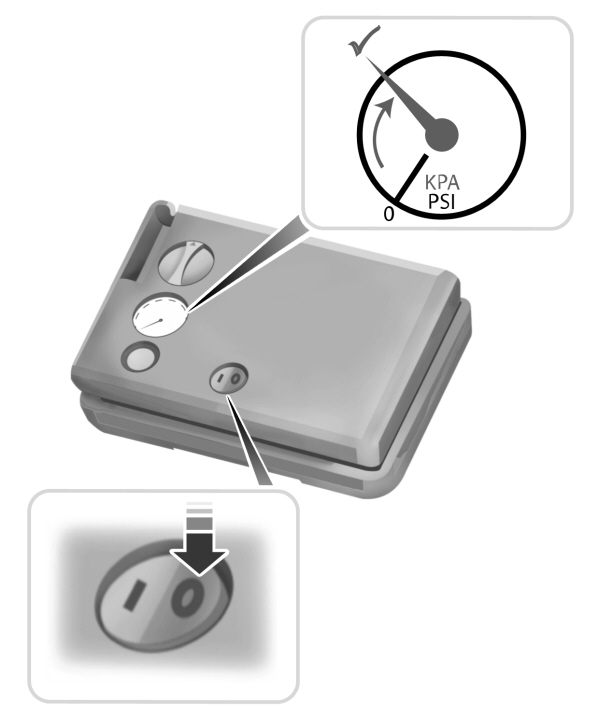
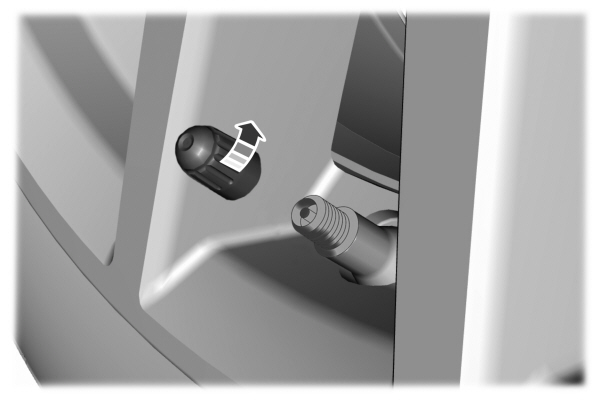



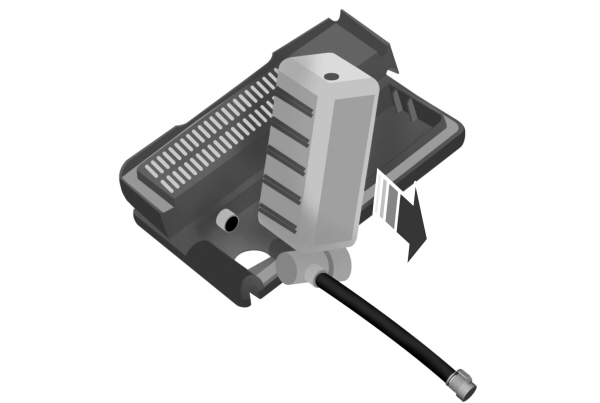

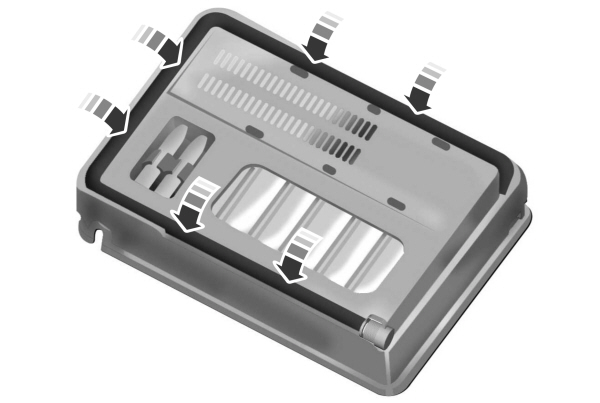
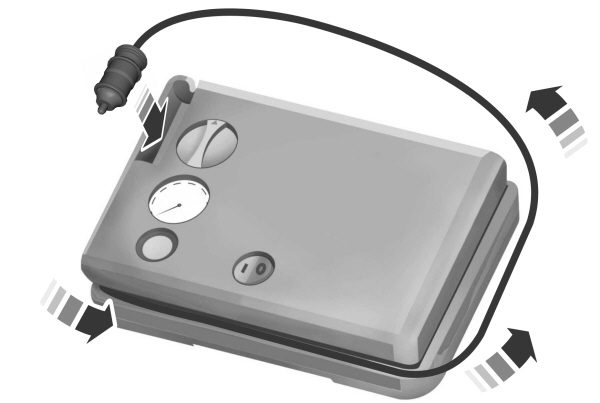
Tips for use of the kit
To make sure the kit operates safely and properly, observe the following:
- Before operating the kit, make sure your vehicle is safely off the road and away from moving traffic.
- Do not remove any foreign objects, such as nails or screws, from the tire.
- Do not allow the compressor to operate continuously for more than 15 minutes. This prevents the compressor from overheating.
- Only use the kit when the ambient temperature is between -22 °F (-30 °C) and 158 °F (70 °C).
- Only use the sealing compound before the use-by date. The use-by date is on a label on the sealant canister and can be seen through the rectangular viewing window on the bottom of the compressor. Check the use-by date regularly and replace the canister when the sealant expires.
Note:
Sealant compound contains latex. Use appropriate precautions to avoid any allergic reactions.
 Place the selector in the Air position when inflating a tire or other objects.
Place the selector in the Air position when inflating a tire or other objects. |
What to do when a tire is punctured
A tire puncture within the tire's tread area can be repaired in two stages with the kit.
- In the first stage, the tire is reinflated with a sealing compound and air. After the tire has been inflated, drive the vehicle a short distance approximately 4 mi (6 km) to distribute the sealant in the tire.
- In the second stage, check the tire pressure and adjust, if necessary, to the vehicle's specified tire inflation pressure.
First Stage: Reinflating the Tire with sealing compound and air
 WARNING:
Do not stand directly over the kit while inflating the tire. If you notice any unusual bulges or deformations in the tire's sidewall during inflation, stop and call roadside assistance.
WARNING:
Do not stand directly over the kit while inflating the tire. If you notice any unusual bulges or deformations in the tire's sidewall during inflation, stop and call roadside assistance. WARNING:
If the tire does not inflate to the recommended tire pressure within 15 minutes, stop and call roadside assistance.
WARNING:
If the tire does not inflate to the recommended tire pressure within 15 minutes, stop and call roadside assistance. |
Park the vehicle in a safe, level and secure area, away from moving traffic.
Turn the hazard lights on. Apply the parking brake and power off the vehicle. Inspect the flat tire for visible damage.
If a puncture is located in the tire sidewall, stop and call roadside assistance.
- Remove the valve cap from the tire valve.
- Unwrap the dual purpose hose (black tube) from the back of the compressor housing.
- Fasten the hose to the tire valve by turning the connector clockwise. Tighten the connection securely.

- Plug the power cable into the 12-volt power point in the vehicle.
- Remove the warning sticker found on the casing/housing and place it on the top of the instrument panel or the center of the dash.

- Turn dial (A) clockwise to the sealant position. Turn the kit on by pressing the on/off button (B).
- Inflate the tire to the pressure listed on the tire label located on the driver door or the door jamb area. Check the final tire pressure with the compressor turned off to get an accurate pressure reading.

- When the recommended tire pressure is reached, turn off the kit, unplug the power cable, and disconnect the hose from the tire valve. Re-install the valve cap on the tire valve and return the kit to the rear of the vehicle.
- Drive the vehicle 4 mi (6 km) to distribute the sealant evenly inside the tire.
Note:
If you experience any unusual vibration, ride disturbance or noise while driving, reduce your speed until you can safely pull off to the side of the road to call for roadside assistance. Do not proceed to the second stage of this operation.
Second Stage: Checking the tire pressure with the inflator kit
 WARNING:
If the tire does not inflate to the recommended tire pressure within 15 minutes, stop and call roadside assistance.
WARNING:
If the tire does not inflate to the recommended tire pressure within 15 minutes, stop and call roadside assistance. WARNING:
The power plug may get hot after use and should be handled carefully when unplugging.
WARNING:
The power plug may get hot after use and should be handled carefully when unplugging. |
Check the air pressure of your tires as follows:

- Remove the valve cap from the tire valve.
- Firmly screw the air compressor hose onto the valve stem by turning clockwise.
- Push and turn the dial clockwise to the air position.
- If required, turn on the compressor and adjust the tire to the recommended inflation pressure.
- Unplug the hoses, re-install the valve cap on the tire and return the kit to the rear of the vehicle.
What to do after the tire has been sealed
After using the kit to seal your tire, replace the sealant canister. Sealant canisters and spare parts can be obtained at an authorized dealer. Empty sealant canisters may be disposed of at home. However, canisters still containing liquid sealant should be disposed of in accordance with local waste disposal regulation.
Removal of the sealant canister from the kit

- Unwrap the dual purpose hose (black tube) from the compressor housing.

- Unwrap the power cord.

- Remove the back cover.

- Rotate the sealant canister up 90 degrees and pull away from casing/housing to remove.
Installation of the sealant canister to the kit
- With the canister held perpendicular to the housing, insert the canister nozzle into the connector and push until seated.
- Rotate the canister 90 degrees down into the housing/casing.

- Snap the back cover back into place.

- Wrap the dual purpose hose (black tube) around the channel on the bottom of the housing/casing.

- Wrap the power cord around the housing and stow the accessory power plug.
- Please note that Ford will not respond to individual feedback.
- Please provide detailed feedback regarding any inaccuracies in the content or any missing content in the Owner's Manual.
- Your feedback will be investigated, and any necessary changes will be updated in the online Owner's Manual.
Your input is valuable in helping us improve our Owner's Manual. Thank you for taking the time to provide your feedback.
